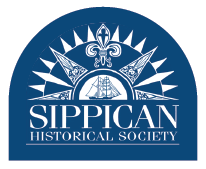Writing from a Front Street home, John G. Nicolay and John Hay were the authorized biographers of an American president – a project that would define his legacy for decades. Do you know which president? Learn more about this Marion connection to the Oval Office.
Lincoln, Nicolay, Hay, and Marion

Years after Lincoln’s birth, life, and death, John George Nicolay (1832-1901) and John Hay (1838-1905) stayed at a Front Street home working on a massive ten-volume biography of the 16th President of the United States. They chose Marion to be closer to Richard Watson Gilder, the editor of The Century Magazine. He’d promised them $50,000 to serialize the biography exclusively for his readers before the complete work would be published – a coup that earned Century Corporation $1 million and doubled the magazine’s circulation to 250,000.
Nicolay and Hay were Lincoln’s private secretaries when he took office in 1861 and worked alongside him until his assassination in 1865. The idea for the biography came early in Lincoln’s presidency, so they’d secured his approval long before he stepped foot in Ford’s Theatre. They also had the approval of Robert Todd Lincoln, Lincoln’s son, but he kept tight reigns on his father’s legacy and his papers. Robert influenced multiple revisions of the manuscript to remove unflattering depictions of Lincoln and his family.
Once published in The Century and as the 10-volume set, readers commented on the “heroic” and “partisan” portrayal of Lincoln. Still, the depiction, and the sections written right here in Marion, became a defining portrayal of Lincoln and the Civil War for decades. Robert agreed to donate his father’s papers to the Library of Congress only if they remained sealed for 21 years after his death. It wasn’t until 1947 that the papers became public for a new generation of biographers and historians to read.
This blog post was written by Adriana Maksy, using the following references:
Nicolay, John G. & John Hay. Abraham Lincoln: A History – Vol. 01. Project Gutenberg, 01 Nov. 2004, https://www.gutenberg.org/cache/epub/6812/pg6812-images.html.
Rosbe, Judith Westlund. Marion in the Golden Age. The History Press: Charleston, 2009.
Zeitz, Joshua. Lincoln’s Boys: John Hay, John Nicolay and the War for Lincoln’s Image. Penguin Books: New York, 2014.
